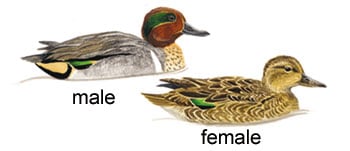The American Kestrel is North America’s smallest falcon. In flight, the kestrel has sharp-looking, pointed wings and a slender, long tail. In comparison to the merlin and peregrine falcon, it is slim. Sharp-shinned and Cooper’s hawks also have long tails, but their wings are broad, not pointed.
While soaring, the kestrel’s wings look more rounded and the tail fans. Adult males are brightly colored, with blue-gray wings and crown, rufous tail, and a rusty back embellished with black barring. Black spots speckle the underparts.
Both sexes have two vertical stripes on the face and a black spot on the back of the neck. Adult females lack the male’s blue-gray wings, have barred tails, and—instead of black spots—sport rusty lines of spots on their underparts.
Listen for
The American Kestrel’s primary call is a high-pitched, excited-sounding killy-killy-killy-killy.
Find it
The American kestrel is not strictly a farm bird, although many farms provide the ideal habitat for them. They also nest and hunt in open urban areas, open forest, clearings, and even deserts. They perch on telephone poles and wires, and nest in boxes put out by concerned land-owners who welcome these insect and rodent eaters.
They are truly American in the New World sense, nesting from Alaska to southern Argentina. In the South, numbers swell in the winter, when northern birds move south en masse to winter in warmer areas.
Feed it
Grasshoppers and other large insects are important prey to kestrels, but voles, mice, and other rodents also play a part in their diet, as do small birds, reptiles, and other small animals.
Nesting Behavior
American kestrels are cavity nesters. Females usually lay their four to six eggs in a tree hole or other cavity, sometimes in a crevice in a building or cliff or in a nest box. Both parents share the month-long incubation duties. Young fly about a month after hatching, and parents feed them until about two weeks after they leave the nest.
WOW!
The spots on the back and sides of a kestrel’s head look like a face. These markings are meant to fool predators into thinking the kestrel is looking at them and is prepared for an attack.
Listen to an American Kestrel:




